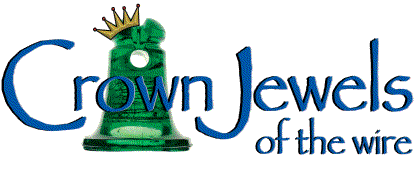A Few Observations
Reprinted from "INSULATORS - Crown Jewels of the Wire", November 1974, page 2
Thought I'd drop a line and thank you for your hospitality at the show. I
really appreciate everything you did for me. I've been reading some of the back
issues of Crown Jewels (for NIA information, specifically), and I'm beginning to
realize what an asset they are.
Dora, you asked me to send in my thoughts concerning my re-entering the
insulator hobby. I did make some observations at the Western Regional Show that
I'd like to share.
* Collectors today seem much, much more particular about the condition of
their insulators than they were, in general, four or five years ago. Chip damage
has always been detracting, but today it seems that every tie wire scratch or
worn spot is carefully considered when evaluating an insulator; and I believe
that this is probably good for the hobby.
* There are so many new varieties of choice insulators that weren't even
discovered four years ago, and the price of such items is so high, that it is
sometimes frustrating to the beginner. The hobby's answer has been
specialization - a predominant trend that had hardly begun four years ago.
* Why do people collect insulators? No matter how the interest in insulators
originates, the beginner spends much of his time hunting, searching for his
insulators. The pleasure of relaxation and refreshment entices many a collector
to leave his busy everyday life routine and spend a sunny Saturday afternoon
walking an abandoned railroad line in the country. Perhaps the greatest
influence is the desire and drive every person seems to have to find some kind
of hidden treasure. If it's not gold at the end of a rainbow, then an insulator
at the base of a telegraph pole will do. I think I can be completely honest in
saying that I derived more thrills in finding my first insulators eight years
ago (Brookfield beehives), than I did in purchasing a mint, glass Cutter for
$13 postpaid in answer to an ad in the Antique Trader.
As the beginner's collection enlarges and his knowledge of insulators
increases, he realizes he will never find all the insulators he's decided he
wants to own. He begins to trade his treasure for someone else's, or he begins
to invest money in his hobby.
Simultaneous with this comes an extremely beneficial and healthy attribute -
personal pride in one's collection. The beginner has become a serious collector.
He has begun to invest and to exhibit his own personality, his own personal
being in his collection.
To increase his own personal evaluation of himself, to arouse the interest of
others in himself, to expand human contact and deepen interpersonal
relationships, the serious collector strives--indeed, competes--to establish a
notable, distinguishable and unique display of insulators.
The collector prides himself in owning an insulator unknown or nearly
unobtainable to other collectors, in owning a complete specialized collection of
some name brand, or style or color. The collector prides himself in winning show
awards for his displays or in his ability to make good trades or sales.
And all of this is healthy--indeed, stimulating. It stimulates communication
among people who otherwise have nothing in common. It stimulates honesty,
friendship and a feeling of personal well being.
But when personality is exhibited, then flaws in a personality also become
evident. We all err. But failure to try to control mistakes shows up in
dishonest dealing, misrepresentation or theft of other collectors' property.
These are shortcut attempts to increase self-esteem or wealth, financial or
otherwise.
Because it is temporarily forgotten that it is we who give value to others
and others who create value for us, these acts of betrayal of interhuman
relationships amount to acts of personality suicide.
Nothing will stagnate a collector or dealer faster than a bad reputation.
But being ignored by other collectors also has a dampening effect upon a
collector. We stand in awe in front of a fine display of threadless, and only
ho-hum our way past a complete, specialized collection of Maydwells. We often
fail to recognize the dedication and personal involvement of one collector,
while we acclaim another; and our faulty judgment is based entirely upon what
type of insulators the person collects.
Finally, we need to encourage more and more new collectors, perhaps even
campaign for them. For, I submit, if new collectors fail to appear, interest
will lag, and older collectors will disappear.
Well, guess I quit editorializing for now. Thanks again for your hospitality.
Your friend,
Howard Banks
N.I.A. Executive Director
| 